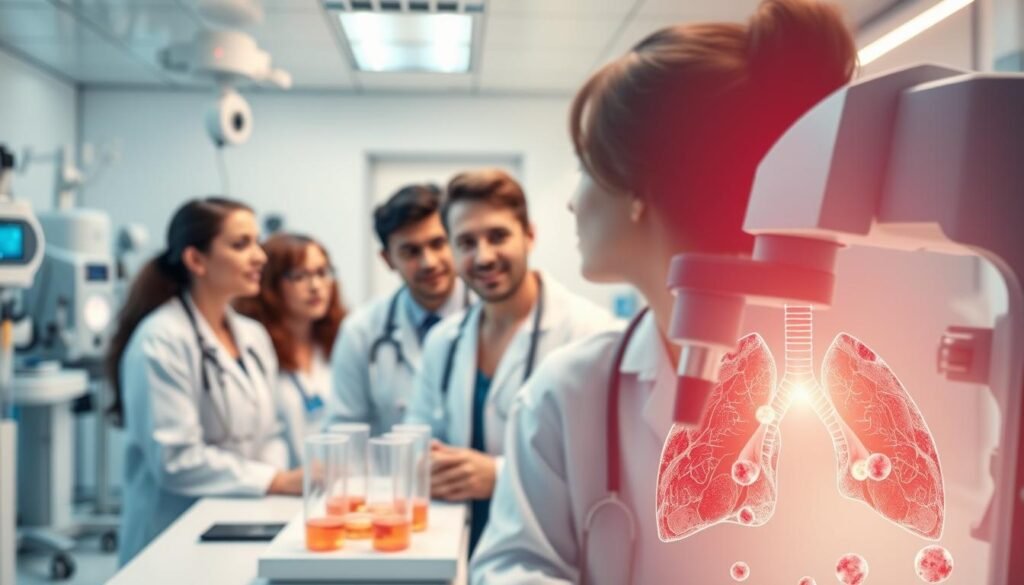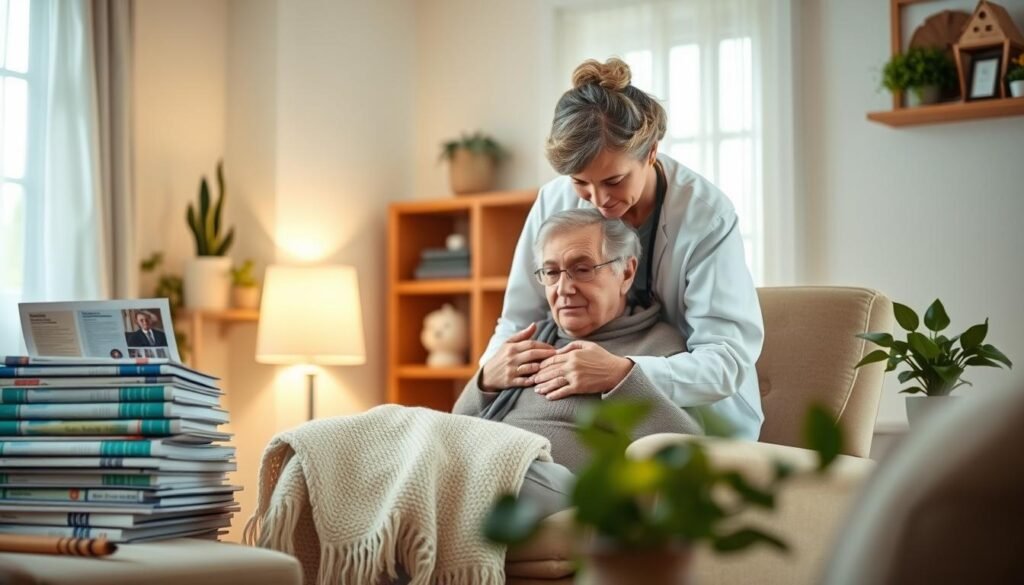Non-Small Cell Lung Cancer (NSCLC) makes up 85 to 90 percent of lung cancer cases in the U.S. This highlights the need for detailed NSCLC resources for patients. It’s vital for patients and caregivers to understand their diagnosis fully. They need the right info on symptoms, treatment options, and support. This guide, supported by reputable sources like the European Society for Medical Oncology (ESMO) and the National Comprehensive Cancer Network (NCCN), offers crucial insights.
This resource spans everything from screening to survivor stories. For those looking for support groups or wanting to learn about treatment options, it lights the way. It aims to support individuals navigating lung cancer’s complexities.
Key Takeaways
- Non-small cell lung cancer represents the vast majority of lung cancer cases in the U.S.
- Educational materials are available for free and written in plain language for ease of understanding.
- Resources address every stage of NSCLC, offering specific guidance for patients diagnosed with stages I through IV.
- Multiple support programs and services are designed to assist patients throughout their cancer journey.
- Guidelines are regularly updated to ensure the highest quality of care is being provided to patients.
- Accessible information is available in Spanish, catering to the needs of diverse patient populations.
Understanding Non-Small Cell Lung Cancer (NSCLC)
Non-Small Cell Lung Cancer, or NSCLC, is the most common type of lung cancer. It makes up about 85-90% of all lung cancer cases. It mainly starts in the lining of the lungs and the bronchi. Knowing about it is crucial for both patients and doctors. NSCLC has three main types: adenocarcinoma (40% of cases), squamous cell carcinoma (25-30%), and large cell carcinoma (10-15%). Each one is different in its risk factors and treatments.
Smoking is the biggest risk factor for NSCLC. Other risks include environmental factors and genetics. Understanding these can help prevent lung cancer. Finding the disease early can lead to better outcomes. This shows why screenings and tests are so important.
Patients should learn medical terms from lung pathology reports after a biopsy. This helps them talk about treatment options more effectively. There are many resources out there, like PDFs with stats, causes, and risks. These offer key insights into NSCLC.
For those wanting to learn more, many tools are available. Quizzes, videos, and advice on quitting smoking can help. These resources can deepen understanding of NSCLC. They highlight the need for early diagnosis. They also encourage patients to be proactive about their health.
Common Symptoms of Lung Cancer
It’s key to spot lung cancer symptoms early. Many people show different signs. Early signals can include:
- Persistent cough
- Coughing up blood or rust-colored sputum
- Chest pain
- Shortness of breath
- Unexplained weight loss
- Fatigue
- Recurring infections
- New onset of wheezing
Lung cancer often goes unnoticed until it’s advanced. But some do notice early signs. Knowing them could lead to early detection and treatment.
In late stages, the symptoms may show the cancer has spread. Signs to watch for include:
- Bone pain
- Neurological changes
- Jaundice
- Swelling of lymph nodes
Conditions like Horner syndrome could develop from Pancoast tumors, linked to a specific lung cancer type. Its symptoms are:
- Drooping or weakness of one upper eyelid
- A smaller pupil on that side of the face
- Less sweating on that side
Lung cancer can also affect the superior vena cava. This can cause swelling in the face, neck, and upper chest. You might also have trouble breathing, get headaches, and feel dizzy.
If you notice these symptoms, see a doctor quickly. Recognizing lung cancer signs can greatly improve your health.
| Symptom | Possible Causes | Immediate Action |
|---|---|---|
| Persistent cough | May indicate lung issues, infection, or other diseases | Consult a healthcare provider |
| Coughing up blood | Could signify serious respiratory conditions | Seek emergency assistance |
| Chest pain | Can be due to various health problems, including lung cancer | Schedule an evaluation with a doctor |
| Shortness of breath | May stem from lung disease or other medical issues | Request immediate medical assessment |
| Unexplained weight loss | Could indicate cancer or metabolic disorders | Contact a healthcare professional |
Diagnosis and Staging of NSCLC
The journey to diagnosing Non-Small Cell Lung Cancer (NSCLC) starts with tests. NSCLC staging is then used to see how far the cancer has spread. This helps decide the best form of treatment.
Staging puts the cancer into categories from 0 to IV. Stage 0 is early, meaning the cancer hasn’t gone deep into lung tissues yet. Stage I is broken into IA and IB, showing the cancer is still just in one place. By Stage II, the situation gets more complex because the size of the tumor and lymph node involvement are considered.
When we reach Stage III, it shows the cancer has spread within the chest. Stage IV is the most severe, with cancer reaching distant parts of the body. Knowing the exact stage helps doctors find the right treatment to improve patient lives.
| Stage | Description |
|---|---|
| 0 | Carcinoma in situ; localized to lung lining |
| I | Localized; IA (small tumor) and IB (slightly larger, still confined) |
| II | Locally advanced; IIA (larger tumor, possible lymph node involvement) and IIB (increased size or spread to nodes) |
| III | Locally advanced; IIIA, IIIB, IIIC indicate spread to mediastinal lymph nodes |
| IV | Metastatic; cancer has spread beyond lungs |
Non-Small Cell Lung Cancer Resources for Patients
Getting the right information is crucial for anyone dealing with non-small cell lung cancer. Many groups offer support and information specially designed for these patients. These resources can help patients understand their treatment choices and find support networks. Below, find educational materials and the latest treatment info to help on your journey.
Educational Materials and Guides
A few organizations are key in providing educational materials for patients. The American Lung Association has a Resource Library full of lung cancer resources for both patients and doctors. CancerCare offers programs tailored to specific concerns, including workshops like Connect Education Sessions. These sessions provide the latest cancer information in easy, one-hour meetings.
Access to Updated Treatment Information
Staying updated on treatment options is key for managing non-small cell lung cancer. The LUNGevity Lung Cancer Helpline gives personalized advice at 844-360-LUNG (5864). The American Lung Association’s Lung HelpLine is another resource, available at 1-800-LUNG-USA (1-800-586-4872), for those looking for treatment advice. For those facing financial hardships, CancerCare offers limited aid for cancer-related expenses to help eligible families.

Lung Cancer Treatment Options
Treatment for non-small cell lung cancer (NSCLC) uses several methods. It depends on the cancer’s stage, the patient’s health, and the tumor’s features. Options mix standard treatments with new therapies. This mix offers hope and improves outcomes for many patients.
Overview of Standard Treatments
Standard treatments for NSCLC cover surgery, chemotherapy, radiation, and targeted therapies. In stage 0, surgery might be all that’s needed. It can often cure the patient. Stage I usually requires removing the tumor and checking nearby lymph nodes.
When the cancer is at stage II, doctors may use chemotherapy with or without immunotherapy. Stage III treatment becomes more complex. It might combine chemotherapy, radiation, immunotherapy, and surgery. Stage IIIB mostly uses chemoradiation with targeted therapy or immunotherapy.
For stages IVA or IVB, patients get a comprehensive mix of treatments. This mix might include surgery, chemotherapy, targeted therapy, immunotherapy, and radiation. It’s critical to check for gene mutations in advanced NSCLC to guide the treatment.
| Stage | Standard Treatments |
|---|---|
| Stage 0 | Surgery |
| Stage I | Surgery |
| Stage II | Neoadjuvant chemotherapy +/- immunotherapy |
| Stage IIIA | Surgery, Chemotherapy, Radiation, Immunotherapy |
| Stage IIIB | Chemoradiation, Targeted therapy, Immunotherapy |
| Stage IV | Surgery, Chemotherapy, Targeted therapy, Immunotherapy, Radiation |
Emerging Therapies and Research
Lung cancer treatment is always changing thanks to new therapies. Immunotherapy is opening new doors for advanced stages. PD-L1 inhibitors, for example, boost the body’s fight against cancer cells. Scientists are looking into oral treatments and immune-boosting drugs through trials.
New radiation methods like stereotactic body radiation therapy (SBRT) target early-stage cancer. They offer hope when surgery isn’t an option. Image-guided radiation therapy (IGRT) ensures precise treatment. These advances are key to longer survival rates and better lives for patients.
Lung Cancer Clinical Trials
Lung cancer clinical trials are important for patients seeking new treatments. They offer access to innovative therapies not yet widely available. Joining NSCLC studies helps patients play an active part in their own care and benefit from latest treatments.
Finding the right clinical trial is a key step. The Lung Cancer Research Foundation offers information on research opportunities. It shows how to check if you are eligible and what to expect if you join.
Being in a clinical trial means getting more attention from the research team. This includes more check-ins and talks about your care. These interactions help patients understand their condition and treatment better.
Here are the benefits of clinical trials:
- Access to new treatments not available in standard practice.
- A chance to be part of breakthroughs in lung cancer care.
- An opportunity to help research that may benefit future lung cancer treatments.
Clinical trials have big benefits, but there are risks too. It’s important to understand what participating means, including side effects. So, talking with your doctors is vital before you decide.

| Trial Name | Focus | Current Status |
|---|---|---|
| BI 1015550 | Efficiency for PF-ILDs | Ongoing |
| ADXS-503 Study | NSCLC Metastatic Treatment | Recruiting |
| Relatlimab vs. Nivolumab | Stage IV NSCLC | Active |
| AERIFY Studies | COPD Treatments | Ongoing |
Support Groups for Lung Cancer Patients
It’s really helpful to connect with others who understand what you’re going through. Support groups offer that chance. They are a key place for sharing stories, tips on getting by, and lifting each other up. Being part of such a group builds strength and a feeling of unity, which is so important when facing tough times.
Finding a Support Group Near You
Finding local support groups for lung cancer is usually easy. Many places like hospitals and community centers have them. The American Cancer Society helps you find groups nearby, so you can meet people who are in the same boat. Meeting face to face can create tight-knit connections and a solid support circle.
Online and Virtual Support Options
If you can’t go to meetings in person, online groups are a great choice. LUNGevity’s Virtual Meetups bring patients and caregivers together from anywhere. This way, no one misses out on the chance for support due to location.
Places like the Cancer Survivors Network also offer a safe place online to share and support each other. Using these online tools helps improve coping methods during the lung cancer journey.
Resources for Lung Cancer Caregivers
Caring for someone with non-small cell lung cancer (NSCLC) is hard. It brings unique challenges and emotional stress. Luckily, many resources are available to help caregivers. These include educational materials, emotional support networks, and practical guides.
Caregivers can find great help from these resources:
- Lung Cancer HELPLine: A toll-free number offering personalized support for patients and their caregivers.
- Peer-to-Peer Mentoring: Provides one-on-one mentorship to handle emotional and logistical challenges in lung cancer care.
- Caregiving Tips: A guide filled with 10 practical tips to assist caregivers on their journey.
- Financial Treatment Program: Programs like Family Reach assist with managing finances related to lung cancer treatment.
- End-of-Life Planning: Helps caregivers deal with the logistical, practical, and emotional aspects of late-stage lung cancer.
- Intelligent Nutrition Assistant: Offers around-the-clock support to maintain a healthy diet during treatment.
Support groups are a big help for caregivers. They connect with others facing similar challenges in online spaces. This fosters strong community ties. Organizations like the American Cancer Society and CancerCare provide support programs. These make it easy to find the help caregivers need.

Caregivers can learn about lung cancer types, stages, and treatments through educational materials. Survivorship resources also prepare them for what patients might face after treatment. With support platforms focused on caregivers, they ensure no one handles these challenges alone.
| Resource | Description |
|---|---|
| Lung Cancer HELPLine | Personalized support for patients and caregivers through a toll-free number. |
| Peer-to-Peer Mentoring | One-on-one mentorship for emotional and logistical support. |
| Caregiving Tips | 10 practical tips to improve the caregiving experience. |
| Financial Treatment Program | Help with managing treatment-related finances. |
| End-of-Life Planning | Resources for handling practical and emotional matters. |
| Intelligent Nutrition Assistant | Support for a healthy diet during treatment. |
Using these valuable resources, caregivers of lung cancer patients can find guidance and support. This greatly enhances their role and journey in caregiving.
Survivor Stories and Personal Experiences
Sharing lung cancer survivor stories gives hope and insight. These stories show the journeys of people facing non-small cell lung cancer (NSCLC). They highlight the power of resilience, emotional health, and strong support during the cancer fight.
Consider Ed’s story. Diagnosed at stage 4 in 2012, he faced a tough road. But joining a Phase One immunotherapy trial was a game-changer for him. By April 2022, Ed was declared free of disease, enjoying five years of better health.
Ina’s recovery is also inspiring. After beating stage 4 Hodgkin’s lymphoma, she faced small cell lung cancer. Her treatment led to five years of remission. It shows that even in the darkest times, there’s hope.
Eileen, another fighter, overcame lung cancer after breast cancer. She’s now living fully, seven years after treatment. Her story highlights how early action and personalized care can change outcomes.
Betty’s experience brings another perspective. Diagnosed in 2001, she didn’t need more treatment after a lobectomy. As part of the Women’s Lung Cancer Forum, she emphasizes the value of support and communication.
Each survivor story teaches us about different paths to recovery. They underline the need for research, patient advocacy, and community support in battling lung cancer. For more stories and info on treatments, check out Teresa’s journey and the latest in treatments.
Conclusion
Living with non-small cell lung cancer (NSCLC) isn’t easy. People face both emotional and physical challenges. But, getting access to detailed non-small cell lung cancer resources helps a lot. It improves patients’ quality of life significantly.
Being educated means patients and families can understand treatment options better. This helps them deal with NSCLC more effectively. They learn how to tackle the disease’s complexities.
Support from patient advocacy groups is crucial. They help lung cancer patients find the information and support they need. With educational materials, clinical trials, and support groups, patients feel less alone. They join a community of others facing the same struggles.
Knowing how important it is to quit smoking and eat right is also key. These lifestyle changes can lead to better health outcomes. They are part of the fight against NSCLC.
Being informed and active in their care makes a huge difference for patients. It’s about the community’s collective strength and individual determination. With the right resources, people facing NSCLC can find hope and keep their spirits up, even when it’s tough.